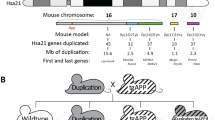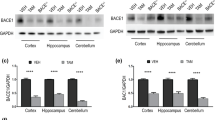Abstract
Down syndrome, the most common genetic disorder leading to mental retardation, is caused by the presence of all or part of an extra copy of chromosome 21. At relatively early ages, Down syndrome patients develop progressive formation and extracellular aggregation of amyloid-β peptide, considered as one of the causal factors for the pathogenesis of Alzheimer’s disease. This neuropathological hallmark has been attributed to the overexpression of APP but could also be contributed by other HSA21 genes. BACE2 maps to HSA21 and is homologous to BACE1, a β-secretase involved in the amyloidogenic pathway of APP proteolysis, and thus it has been hypothesized that the co-overexpression of both genes could contribute to Alzheimer’s like neuropathology present in Down syndrome. The aim of the present study has been to analyse the impact of the co-overexpression of BACE2 and APP, using a double transgenic mouse model. Double transgenic mice did not present any neurological or sensorimotor alterations, nor genotype-dependent anxiety-like behaviour or age-associated cognitive dysfunction. Interestingly, TgBACE2-APP mice showed deregulation of BACE2 expression levels that were significantly increased with respect to single TgBACE2 mice. Co-overexpression of BACE2 and APP did not increase amyloid-β peptide concentration in brain. Our results suggest that the in vivo effects of APP are not exacerbated by BACE2 co-overexpression but may have some protective effects in specific behavioural and cognitive domains in transgenic mice.






Similar content being viewed by others
References
Acquati F, Accarino M, Nucci C, Fumagalli P, Jovine L, Ottolenghi S, Taramelli R (2000) The gene encoding DRAP (BACE2), a glycosylated transmembrane protein of the aspartic protease family, maps to the down critical region. FEBS Lett 468:59–64
Altafaj X, Dierssen M, Baamonde C, Marti E, Visa J, Guimera J, Oset M, Gonzalez J, Florez J, Fillat C, Estivill X (2001) Neurodevelopmental delay, motor abnormalities and cognitive deficits in transgenic mice overexpressing Dyrk1A (minibrain), a murine model of Down’s syndrome. Hum Mol Genet 10:1915–1923
Arqué G, Fotaki V, Fernández D, Martínez de Lagrán M, Arbonés ML, Dierssen M (2008) Impaired spatial learning strategies and novel object recognition in mice haploinsufficient for Dyrk1A. PLoS ONE 3:e2575
Arqué G, Martínez de Lagrán M, Arbonés ML, Dierssen M (2009) Age-associated motor and visuo-spatial learning phenotype in Dyrk1A heterozygous mutant mice. Neurobiol Dis 36:312–319
Azkona G, Amador-Arjona A, Obradors-Tarrago C, Varea E, Arque G, Pinacho R, Fillat C, de la Luna S, Estivill X, Dierssen M (2010) Characterization of a mouse model overexpressing beta-site APP-cleaving enzyme 2 reveals a new role for BACE2. Genes Brain Behav 9(2):160–172
Basi G, Frigon N, Barbour R, Doan T, Gordon G, McConlogue L, Sinha S, Zeller M (2003) Antagonistic effects of beta-site amyloid precursor protein-cleaving enzymes 1 and 2 on beta-amyloid peptide production in cells. J Biol Chem 278:31512–31520
Busciglio J, Pelsman A, Wong C, Pigino G, Yuan M, Mori H, Yankner BA (2002) Altered metabolism of the amyloid beta precursor protein is associated with mitochondrial dysfunction in Down’s syndrome. Neuron 33:677–688
Cheon MS, Fountoulakis M, Dierssen M, Ferreres JC, Lubec G (2001) Expression profiles of proteins in fetal brain with Down syndrome. J Neural Transm 61:311–319
Cheon MS, Dierssen M, Kim SH, Lubec G (2008) Protein expression of BACE1, BACE2 and APP in Down syndrome brains. Amino Acids 35:339–343
Coussons-Read ME, Crnic LS (1996) Behavioral assessment of the Ts65Dn mouse, a model for Down syndrome: altered behavior in the elevated plus maze and open field. Behav Genet 26:7–13
Dierssen M, Màrmol F, Vivas NM, Clos V, Badia A (1992) Posttrain administration of 9-amino-1,2,3,4-tetrahydroacridine enhances passive avoidance retention and decreases β-adrenoceptor linked cyclic AMP formation in middle-aged rats. Brain Res 586:117–120
Dierssen M, Fotaki V, Martinez de Lagran M, Gratacos M, Arbones M, Fillat C, Estivill X (2002) Neurobehavioral development of two mouse lines commonly used in transgenic studies. Pharmacol Biochem Behav 73:19–25
Escorihuela RM, Fernández-Teruel A, Vallina IF, Baamonde C, Dierssen M, Tobeña A, Flórez J (1995) A behavioral assessment of Ts65Dn mice: a putative Down syndrome model. Neurosci Lett 199:143–146
Escorihuela RM, Martínez-Cué C, Vallina IF, Baamonde C, Dierssen M, Tobeña A, Flórez J, Fernández-Teruel A (1998) Impaired short- and long-term memory in Ts65Dn mice. Neurosci Lett 247:171–174
Farzan M, Schnitzler CE, Vasilieva N, Leung D, Choe H (2000) BACE2, a beta-secretase homolog, cleaves at the beta site and within the amyloid-beta region of the amyloid-beta precursor protein. Proc Natl Acad Sci USA 97:9712–9717
Ferrer I, Barrachina M, Puig B, Martínez de Lagrán M, Martí E, Gómez-Isla T, Avila J, Dierssen M (2005) Constitutive Dyrk1A is abnormally expressed in Alzheimer disease, Down syndrome, dementia with Lewy bodies, Pick disease and related transgenic models. Neurobiol Dis 20:392–400
Harris-Cerruti C, Kamsler A, Kaplan B, Lamb B, Segal M, Groner Y (2004) Functional and morphological alterations in compound transgenic mice overexpressing Cu/Zn superoxide dismutase and amyloid precursor protein. Eur J Neurosci 19:1174–1190 (correction)
Holtzman DM, Santucci D, Kilbridge J, Chua-Couzens J, Fontana DJ, Daniels SE, Johnson RM, Chen K, Sun Y, Carlson E, Alleva E, Epstein CJ, Mobley WC (1996) Developmental abnormalities and age-related neurodegeneration in a mouse model of Down syndrome. Proc Natl Acad Sci USA 93:13333–13338
Hussain I, Powell D, Howlett DR, Tew DG, Meek TD, Chapman C, Gloger IS, Murphy KE, Southan CD, Ryan DM, Smith TS, Simmons DL, Walsh FS, Dingwall C, Christie G (1999) Identification of a novel aspartic protease (Asp 2) as beta-secretase. Mol Cell Neurosci 14:419–427
Hussain I, Powell DJ, Howlett DR, Chapman GA, Gilmour L, Murdock PR, Tew DG, Meek TD, Chapman C, Schneider K, Ratcliffe SJ, Tattersall D, Testa TT, Southan C, Ryan DM, Simmons DL, Walsh FS, Dingwall C, Christie G (2000) ASP1 (BACE2) cleaves the amyloid precursor protein at the beta-secretase site. Mol Cell Neurosci 16:609–619
Lamb BT, Sisodia SS, Lawler AM, Slunt HH, Kitt CA, Kearns WG, Pearson PL, Price DL, Gearhart JD (1993) Introduction and expression of the 400 kilobase amyloid precursor protein gene in transgenic mice. Nat Genet 5:22–30 (corrected)
Lott IT, Dierssen M (2010) Down syndrome: neurological complications and cognition. Lancet Neurol (in press)
Martínez de Lagrán M, Altafaj X, Gallego X, Martí E, Estivill X, Fillat C, Dierssen M (2004) Motor phenotypic alterations in TgDyrk1A transgenic mice implicate DYRK1A in Down syndrome motor dysfunction. Neurobiol Dis 15:32–142
Mattson MP (2004) Pathways towards and away from Alzheimer’s disease. Nature 430:631–639
Murphy GM Jr, Eng LF, Ellis WG, Perry G, Meissner LC, Tinklenberg JR (1990) Antigenic profile of plaques and neurofibrillary tangles in the amygdala in Down’s syndrome: a comparison with Alzheimer’s disease. Brain Res 537:102–108
Rogers DC, Fisher EM, Brown SD, Peters J, Hunter AJ, Martin JE (1997) Behavioral and functional analysis of mouse phenotype: SHIRPA, a proposed protocol for comprehensive phenotype assessment. Mamm Genome 8:711–713
Sago H, Carlson EJ, Smith DJ, Kilbridge J, Rubin EM, Mobley WC, Epstein CJ, Huang TT (1998) Ts1Cje, a partial trisomy 16 mouse model for Down syndrome, exhibits learning and behavioral abnormalities. Proc Natl Acad Sci USA 95:6256–6261
Sambamurti K, Kinsey R, Maloney B, Ge YW, Lahiri DK (2004) Gene structure and organization of the human beta-secretase (BACE) promoter. FASEB J 18:1034–1036
Solans A, Estivill X, de La Luna S (2000) A new aspartyl protease on 21q22.3, BACE2, is highly similar to Alzheimer’s amyloid precursor protein beta-secretase. Cytogenet Cell Genet 89:177–184
Sun X, He G, Song W (2006) BACE2, as a novel APP theta-secretase, is not responsible for the pathogenesis of Alzheimer’s disease in Down syndrome. FASEB J 20:1369–1376
Vassar R, Bennett BD, Babu-Khan S, Kahn S, Mendiaz EA, Denis P, Teplow DB, Ross S, Amarante P, Loeloff R, Luo Y, Fisher S, Fuller J, Edenson S, Lile J, Jarosinski MA, Biere AL, Curran E, Burgess T, Louis JC, Collins F, Treanor J, Rogers G, Citron M (1999) Beta-secretase cleavage of Alzheimer’s amyloid precursor protein by the transmembrane aspartic protease BACE. Science 286:735–741
Wisniewski KE, Dalton AJ, McLachlan C, Wen GY, Wisniewski HM (1985) Alzheimer’s disease in Down’s syndrome: clinicopathologic studies. Neurology 35:957–961
Yan R, Munzner JB, Shuck ME, Bienkowski MJ (2001) BACE2 functions as an alternative alpha-secretase in cells. J Biol Chem 276:34019–34027
Acknowledgments
We thank Jerome McDonald and Nuno Duarte Sendas Sampaio de Vasconcelos for their technical support. The laboratory of M.D. is supported by the DURSI (2009SGR1313) and the Departament de Salut of the Catalan Autonomous Government. This work was supported by grants from the Spanish Ministry of Education and Science (FCT-08-0782, SAF2007-60827, SAF2007-31093-E), FIS (PI 082038), Marató TV3 (062230), Jerome Lejeune Foundation (JMLM/AC/08-044), Reina Sofia and Areces Foundations and EU (LSHG-CT-2006-037627; EU/FIS PS09102673, CureFXS ERA-NET E-Rare: EU/FIS PS09102673). The CIBER of Enfermedades Raras is an initiative of the ISCIII. G.A. received additional support from the Basque Government (BFI05.48).
Author information
Authors and Affiliations
Corresponding author
Electronic supplementary material
Below is the link to the electronic supplementary material.
726_2010_662_MOESM1_ESM.tif
Fig. 1. Preweaning behaviour. No significant differences among genotype were found neither in the weight gain (gr., A) of mouse pups during the preweaning period, nor in the appearance of developmental physical landmarks (B) or in the achievement of mature responses in several reflexological and behavioural tasks (C). Data are expressed as mean ± S.E.M. Supplementary material 1 (TIFF 30350 kb)
Rights and permissions
About this article
Cite this article
Azkona, G., Levannon, D., Groner, Y. et al. In vivo effects of APP are not exacerbated by BACE2 co-overexpression: behavioural characterization of a double transgenic mouse model. Amino Acids 39, 1571–1580 (2010). https://doi.org/10.1007/s00726-010-0662-8
Received:
Accepted:
Published:
Issue Date:
DOI: https://doi.org/10.1007/s00726-010-0662-8




